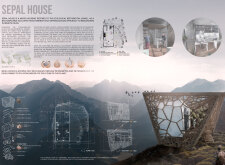5 key facts about this project
Sepal House is a micro housing unit built for ecological restoration in remote forest areas that face environmental harm. With a focus on supporting researchers, the structure aims to aid the recovery of biodiversity in regions impacted by pollution and other threats. The design concept centers on being modular and adaptable, allowing it to fit into the natural surroundings while keeping its environmental impact low.
Modular Design
The design consists of two layers that work together to create a functional space. The outer layer serves as a protective shell, while the inner core is constructed using ecological structural insulated panels. These panels provide effective space management and good insulation. The modular design allows for quick assembly in challenging locations, making it easier to set up in remote areas.
Sustainable Materials
For the external layer, lenga wood is chosen for its ability to blend with the surrounding environment. This material not only enhances the structure’s natural look but also supports ecology as it decays over time, allowing plants to grow back and giving animals a place to thrive. Using sustainable materials reflects a commitment to environmental care.
Functional Integration
Inside, clean energy systems are integrated into the core, enabling the unit to operate without creating waste. This aspect is essential for researchers, as it allows them to carry out their work even in isolated conditions. Additionally, the internal layer can be removed and reused for future projects, extending the life of materials and enhancing overall utility.
The design features an intermediate space between the two layers that acts as a cushion, reducing the impact on the environment. This thoughtful design element shows that human activity can coexist with nature, supporting essential research while respecting the ecosystem.



















































